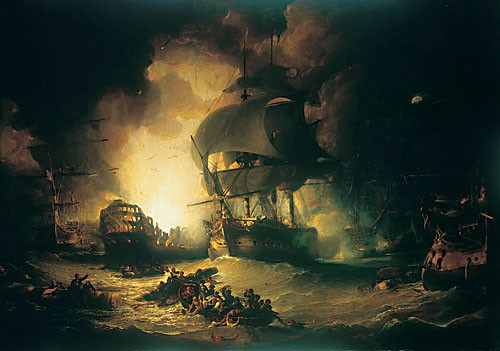On 1 August, 1798, a month after the landing of French troops in Egypt at Alexandria, the French fleet was completely destroyed by the British Navy in Aboukir Bay, known in English as the Battle of the Nile, the only other significant Franco-British naval engagement of the period (alongside Trafalgar in 1805). Joining battle just as the sun was setting, Nelson made an exceedingly daring attack (for which was named 'Baron of the Nile', hence the crocodile in his coat of arms), culminating in the explosion of the French flag ship, L'Orient, at about 10pm which sealed the French defeat long before the fighting ceased. It was this cataclysmic moment that the British painter, George Arnald, chose to depict in his 1825 commission from the Naval Gallery of Greenwich Hospital in London.
The centre of the composition is taken up by the British vessel Swiftsure, sails billowed by the force of the explosion. Indeed the blast – caused by a cannonball entering the powder magazine – was so violent that not only was it apparently heard in Alexandria but also the battle ceased for about 15 minutes in awe at the event. To the left, L'Orient, a three-decker with 118 cannon (built at Toulon) and a crew of more than one thousand men, appears like a ghost ship in the powerful light of the fire. And this light set against the night and the smoke gives a huge dramatic intensity to the work, underlining the sense of human tragedy. In the foreground, on the turbid waters, men packed into a rowing boat attempt to fish out those in the water, whilst others grip onto the flotsam and jetsam of masts and spars blown into the water by the cannon blasts. A witness (not so much eyewitness, since as a gunner he was below deck and saw almost nothing of the battle as it happened) the British gunner, John Nichol, from Goliath, recorded his thoughts after the explosion : ” When the French flagship blew up, Goliath was so shaken that we thought that the stern of our ship had exploded […] When the firing stopped, I went on deck to see what state the fleets were in and it was a horrible sight. The whole bay was entirely covered with mutilated corpses, the wounded, the burned, wearing no clothes other than trousers. There were a few Frenchmen from the flagship L'Orient pressed up against the poop of Goliath. Poor men!”. The painting was a huge success when it was shown in London in 1827. This sombre vision, in no way triumphalist, bears witness to the most ghastly moment of the Battle of the Nile.
Karine Huguenaud (tr. P.H.)
March 2004
The destruction of l’Orient during the Battle of the Nile (Aboukir)
Artist(s) : ARNALD George

- Date :
- 1825
- Technique :
- oil on canvas
- Dimensions :
- H = 1.85 m, L = 2.69 m
- Place held :
- London, National Maritime Museum, Greenwich Hospital Collection

